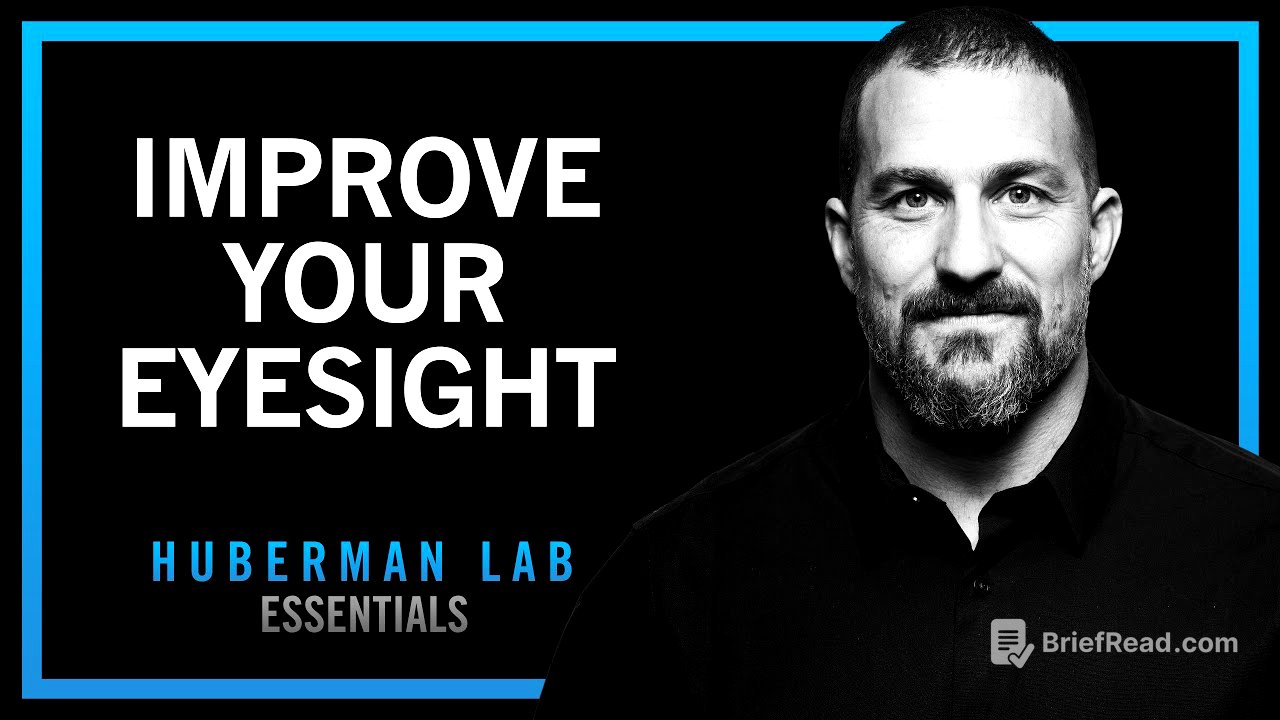TLDR;
This episode of Huberman Lab Essentials focuses on vision and eyesight, explaining how our eyes influence mood, alertness, and overall health. It covers the importance of light intake through the eyes, the function of different cells within the retina (rods, cones, and melanopsin cells), and how the brain processes visual information. Practical tools and protocols are provided to improve and maintain eyesight, including managing screen time, getting sunlight exposure, and incorporating specific eye exercises. The episode also touches on the role of nutrition and supplements in supporting vision health.
- Eyes are extensions of the brain and crucial for overall health.
- Light exposure through the eyes regulates mood, sleep, and appetite.
- Practical tools can improve eyesight and reduce nearsightedness.
Huberman Lab Essentials; Improve Vision [0:00]
Andrew Huberman introduces the episode as a focused exploration of vision and eyesight, an area he has dedicated over 25 years to studying. He emphasises that vision encompasses more than just eyesight, influencing mood and alertness. The goal is to provide actionable, science-based tools to enhance mental and physical well-being through understanding and improving vision.
Eyes, Lens, Eyelashes [1:01]
The eyes are described as the primary entry point for light information into the body, with the neural retinas being a direct extension of the central nervous system. Key components of the eye, such as the lens, which focuses light onto the retina, and the eyelashes, which trigger the blink reflex to protect the cornea, are highlighted. Eyelids are also mentioned for their role in alertness, setting the stage for discussing how the visual system can be used to increase alertness.
Retina, Photoreceptors & Brain [2:40]
The primary function of the eyes is to convert light into a form of information that the brain can interpret. This process involves photoreceptor cells, specifically rods for low-light vision and cones for daytime vision. These cells use chemical reactions, including vitamin A, to convert light into electrical signals. The brain then interprets these signals, creating perceptions of colour, depth, and shapes. The brain uses about 40 to 50% of its resources for vision.
Eyesight & Subconscious Vision Effects [6:34]
Beyond conscious eyesight, vision significantly impacts subconscious functions like mood, sleep, and appetite. Protocols designed to enhance eyesight can also positively influence these subconscious aspects. Understanding the science behind vision is crucial for leveraging these protocols effectively.
Time of Day & Retina, Tool: Morning Sunlight Exposure [7:25]
The most ancient function of our eyes is to communicate time of day to the brain and body. Melanopsin retinal ganglion cells play a key role in this process, responding to specific qualities of light to regulate the circadian clock, metabolism, blood sugar, dopamine levels, and pain threshold. Exposure to sunlight, especially in the morning, is essential for triggering these cells and anchoring our biological clock. Aim for 2-10 minutes of early morning sunlight exposure.
Tool: Reduce Nearsightedness & Outdoor Time [10:25]
Spending at least two hours a day outdoors without sunglasses can significantly reduce the risk of developing myopia (nearsightedness). The lens in the eye is dynamic, adjusting its shape through a process called accommodation to focus light onto the retina.
Accommodation, Focus, Tools: Panoramic Vision; Upward Gaze [10:56]
Accommodation, the ability to focus on objects at varying distances, is crucial for both eye health and mental focus. Prolonged close-up work, like using phones and computers, strains the eyes and can negatively reshape neural circuitry. To combat this, take breaks every 30 minutes to practice panoramic vision and relax eye muscles. Looking upwards toward the ceiling can also stimulate wakefulness.
Improve Vision, Tools: View Distances; Smooth Pursuit; Accommodation [14:43]
To improve vision, spend at least 10 minutes daily viewing objects in the distance to maintain lens elasticity. Practice smooth pursuit by tracking moving objects to keep the visual and motion tracking systems coordinated. Additionally, practice accommodation by focusing on objects at varying distances to exercise the lens muscles.
Binocular Vision, Lazy Eye, Children [17:36]
The young brain is highly susceptible to differences in visual input between the two eyes. Ensuring good binocular vision, especially in children, is crucial for developing strong visual machinery in the brain. Correcting imbalances, such as lazy eye (amblyopia) or strabismus, as early as possible is essential for balanced vision.
Hallucinations & Visual System [20:25]
Hallucinations can occur due to underactivation of the visual portions of the brain, leading the visual system to compensate by creating its own activity. This explains why people in completely dark environments may start to hallucinate.
Improve & Test Vision, Tool: Snellen Chart [21:38]
Using a Snellen chart at home can help monitor and improve vision. Regular testing can provide insights into vision changes and the effectiveness of visual training exercises. It's important to consult an ophthalmologist or optometrist for professional vision testing, especially when considering corrective lenses or surgery.
Support Vision, Tool: Vitamin A & Vegetables [23:44]
Consuming vegetables rich in vitamin A, such as dark leafy greens and carrots, supports vision by providing essential components for the biochemical processes in the retina. While excessive intake won't drastically improve vision, maintaining adequate vitamin A levels is crucial for optimal eyesight.
Supplements, Lutein, Astaxanthin [25:11]
Lutein supplementation may help offset the detrimental effects of age-related macular degeneration in individuals with moderate to severe cases. Astaxanthin, found in seafood, can increase ocular blood flow and has shown positive effects on skin health.
Recap & Key Takeaways; Cardiovascular System [27:32]
The episode recaps various behavioural and supplementation tools to support and enhance vision, tailored to individual needs and risk factors. Maintaining a healthy cardiovascular system is emphasised as essential for delivering blood, oxygen, and nutrients to the metabolically active cells in the retina, supporting overall brain health and vision.









